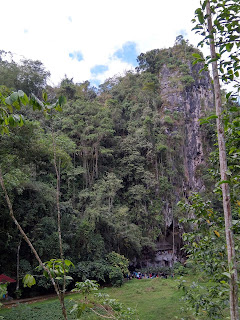Chapter 2- Hometown Road- The Funeral and Via Dolorosa
Heyaa...
This is second chapter of my hometown Road story.
Actually all draft was done...with the pictures.
Then deleted by mistake.
I hate to have to write again but I feel like I need to write this down. I have to...
Third day in Toraja I visited graveyards: Londa, a funeral and Late afternoon were closing the day at Sa'pak Boyo-Boyo for a via Dolorosa- and a candle carnivals with the bishop.
Londa is a must visit site. It is located very close again to our hotel so we stopped by.
Seems like nothing change here also there was not many visitors.
People come to see the coffins and Tau-tau which are effort less displayed on the edge of hills and caves.
 |
| Londa, must visit place or, recognized site in Toraja. Located about 5 km from Rantepao |
 |
| Coffns, stacked in the cliff |
 |
| General views of the site, coffin and Tau-tau (dead body representative doll) |
 |
| Here to memorize the family whose dead body buried (placed) in the cave. |
People then usually get into the cave with torch with a guide, to see bones or skulls. I personally does not like mysticism and energy of the death. So I was just recall memories of the sceneries and the outside cave. I was focusing on the funeral. How it will be and how to face the indigineous people and relatives who I have no idea how they look like. I was excited.
Then here time has arrived to see the beginning of funeral ceremony of Toraja people.
Most tourists or visitor asked why, why always about grave, coffin, death and funeral in Toraja.
Answer is simple. The indigineous culture in this land believe in life after death. Then again, Toraja people keep the belief and tradition from generation to generation, inculturated to Christianity ( most adapted religion here).
 |
| First question, what happened when someone died in Toraja. Reply: How much money they have? How wealth is the family? Are they strong in tradition? |
 |
| As I mentioned in my previous blog about Tongkonan, the traditional house is functional as well as symbolize wealth of the family |
 |
| Family works hard on 11 -14 days of funeral ceremony, starting from day 1, cooking, preparing food, serving guest, while men...receiving guests and slaying the offerings. |
As Indonesian who has Toraja blood, but very liquid traditions, being in the ceremony sometimes is needed.It is reminded me of my late grandma, the families here who we just met today and all the complications of culture. The costly tradition is not for me, logically, in the modern tradition of my family today, the ceremony is way out too much in everything, beyond logic.
However, I am glad tradition is still here. Toraja culture represent one of most unique indigenous that is still exist today. Apart from modern world, being in the all traditional complications was a great experience. I witness how the culture has been simplified and modified to modern touch,
understanding now people are not so into the ancient belief of "Aluktodolo" - the animism and dinamism belief, the ceremony of funeral called "Rambu Solo" is now show more attractions or as commodity more than the genuine value itself. To be honest, the ceremony only is distinctive and exotic.
Now move to my best part of the trip. The Via Dolorosa- at Sa'Pak Boyo-boyo. I was so glad i was here. I am not religious, maybe, but my spirituality, was slightly awaken here (ahahahh!!!) No, it was true. The pathways was hard, the road was hard, rocky, climbing and unstable, but it was worthed.
 |
| First stop |
 |
| The Sa'pak Boyo-boyo religious site was built in a village of Holy Family of Nazareth , Sanggala |
 |
| The group who we are joining for the trip |
You must wear shoes, or hiking slip on. Was not easy to walk here.
However, Views were amazing.
As usual, I would like to close the chapter with some human interest pictures.
Despite the nature, unique culture, the carving, the fabrics and the banana, I love the people most.
They are warm and super chic. Have a look and see you again on the next chapter!
Ce ha I en te a
 |
| Lady in a very chic outfit I met in Via Dolorosa path |
 |
| Cool hat, cool blazer...what a cool old guy! |
 |
| I regret didn't take full photo of his outfit |
 |
| Human size Tau-tau. She is so much blessed and respected. |
 |
| My coffee guy. Very passionate about farming and coffee. |
 |
| Introducing Tasya, favorite cousin number 1. We call her Ci Tor- Chinese Toraja! |





Komentar
Posting Komentar